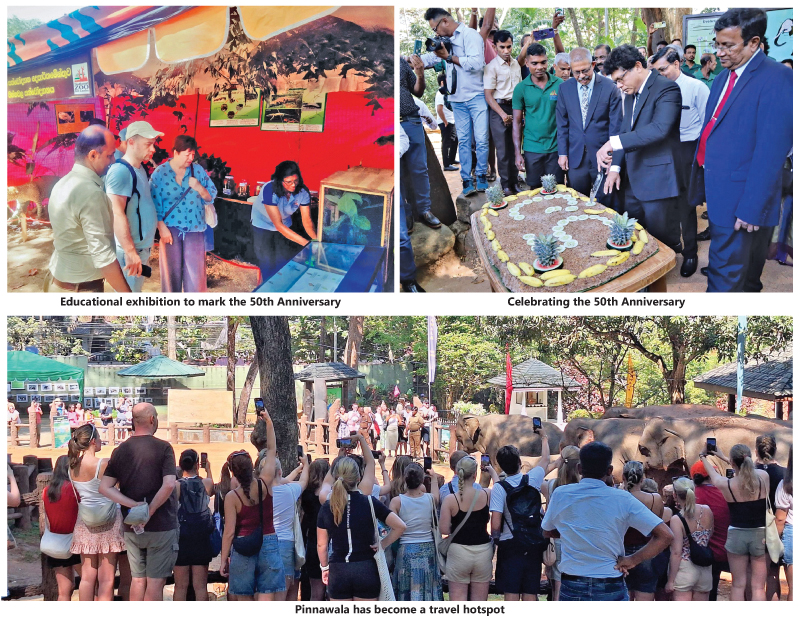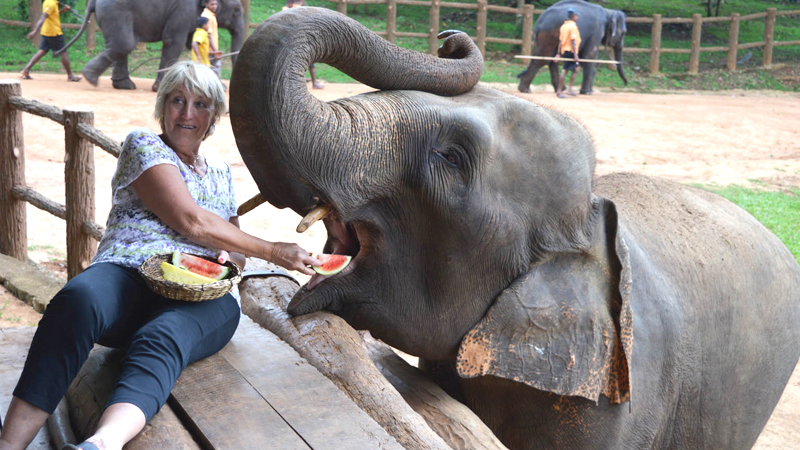 Kumari, Mathali and Neela, three of the first five occupants of the Pinnawala Elephant Orphanage, are in the age of grace but in fine fettle as their home celebrates the Golden Jubilee on a high note. They have seen how the facility, which started as a small refuge, rose to international fame as the largest ex-situ conservation breeding centre for Asian elephants. They have seen three generations grow under the watchful eye of its keepers, who sense their needs and moods in a heartbeat through years of experience. The other two of the first five, Vijaya and Kadira, are no more, but their offspring carry on their legacy.
Kumari, Mathali and Neela, three of the first five occupants of the Pinnawala Elephant Orphanage, are in the age of grace but in fine fettle as their home celebrates the Golden Jubilee on a high note. They have seen how the facility, which started as a small refuge, rose to international fame as the largest ex-situ conservation breeding centre for Asian elephants. They have seen three generations grow under the watchful eye of its keepers, who sense their needs and moods in a heartbeat through years of experience. The other two of the first five, Vijaya and Kadira, are no more, but their offspring carry on their legacy.
The Pinnawala Elephant Orphanage, a major tourist attraction in Sri Lanka, is currently home to 68 elephants (40 females and 28 males), including five baby elephants (two females and three males). The charming sight of the herd walking down to the Ma-Oya, bathing and playing around has stolen the hearts of many visitors and continues to do so. These breathtaking moments, captured through the lens, have travelled far and wide, gracing the cover-pages of many prestigious magazines and websites, earning numerous accolades.
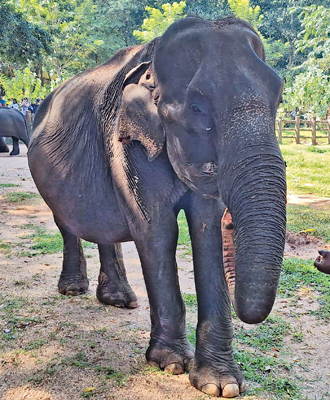
Kumari, one of the first five inmates of the Orphanage
The elephant orphanage was founded on February 16, 1975, on a concept by the then Shipping and Tourism Minister, the late P. B. G. Kalugalle, to feed and care for un-weaned elephants displaced from their wild habitat. It was initially under the purview of the Wildlife Conservation Department, but has been vested with the National Zoological Gardens since 1982.
Breeding ground
A 23-acre plot of land selected for the purpose was a coconut plantation, and some of those trees remain even today, providing shade and food for the elephants. The elephants love to strip and munch on coconut leaves as they roam the area, also exchanging curious glances with the visitors who have come to see them.
Sukumali was born to Vijaya and Kumari in 1984, marking the first birth at the facility. Since then, it has gradually become a successful breeding centre for tamed elephants, recording 76 births to date.
The near-natural environment facilitated for the elephants has created favourable conditions for their breeding. Kumari and Mathali, now in the autumn of life, are mothers of five each, while Sukumali is also a mother of three.
Pinnawala Elephant Orphanage Deputy Director Mihiran Medawala said Kumari has recovered after a period of illness. The Orphanage organised a Pirith chanting event in January to invoke blessings upon her, while veterinarians worked around the clock to restore her health. “She has regained health faster, and is now enjoying her time freely,” Medawala said.
Pinnawala recorded a milestone with the birth of twin baby elephants, Sajjana and Disa, in 2021, marking another first at the orphanage and a rare event globally. These two young calves, along with Neelamani, born in the same year, and Dharani and Dharana, born in 2022 and 2024 have touched the hearts of all visitors.
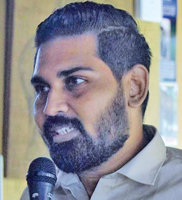
Pinnawala Elephant
Orphanage Deputy Director Mihiran Medawala
Speaking to the Sunday Observer, Medawala said that bottle-feeding calves no longer takes place at the centre as their real mothers are around to breastfeed them. “We did not receive an elephant from the wild after around 2013. Such elephants are now being treated and taken care of by the Wildlife Conservation Department through the Elephant Transit Homes in Giritale and Udawalawe,” he said.
Daily routine
Medawala said that donating elephants to temples had occurred in the past as per Government directives, but the practice had ceased from around 2016. The facility, however, sends experienced and well-tamed elephants for the Dalada Perahera in Kandy and other prominent cultural events. The elephant conservatory is also home to eight elephants, which were illegally kept by various individuals in the past, as per a Court order.
About 200 staff members, including 80 elephant keepers and two veterinarians, attend to the daily needs of the animals. “While the water requirement is fulfilled by the Ma-Oya, we need about 15,000 kilograms of fodder daily for the giant creatures in our care. Jackfruit, coconut and Kithul leaves and trunks, and a high-yield grass variety known as ‘Co4’ form the bulk of green matter for the elephants. These are procured through tenders,” the Deputy Director explained.
Visitor magnet
The Pinnawala Elephant Orphanage is open to visitors from 8.30am to 5.45pm. Explaining the routine of the Pinnawala elephants, he said that a herd of about 25 female elephants, along with the calves and occasionally a male elephant, is released to a free-roaming area around 8.30am, escorted for river bathing twice a day at 10am to 12 noon and 2pm to 4pm, after which they are returned to their sheds until the next day. The male elephants, which enjoy less freedom compared to their counterparts, are taken to the river separately.
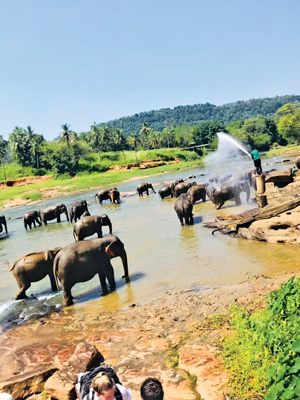
Elephants in Pinnawala taken to Ma-Oya twice everyday
He said that a limited number of tourists are given the opportunity to participate in bathing the elephants for about 15 minutes after purchasing a separate ticket.
Asked whether the centre provides guided tours for tourists, Medawala, who replied in the negative, said that it has been difficult as the majority of foreign tourists, who come, are non-English speakers from countries like China, Russia, Ukraine, Germany, France and India. The Deputy Director said that under the foster parent programme of the Orphanage, interested individuals or organisations can sponsor an elephant of their choice. “For an adult elephant, we have to spend about Rs. 20,000 per day. The orphanage also welcomes material donations such as medicine and equipment from well-wishers” he added.
Although, it was started with the main objective of caring for orphaned baby elephants, the facility, as it celebrates 50 years of operation, has successfully expanded its scope to include animal welfare, tourism, education, research, and recreation.
The Deputy Director said that the Orphanage recorded an income of Rs 956 million in 2024, with 650,072 visitors (477,132 local, 172,940 foreign). Compared to 2023, visitor arrivals have increased by about 82,650 and the revenue has risen by approximately Rs 400 million. Parallel to the Golden Jubilee celebrations, an educational exhibition was held at the premises from February 14-16, providing visitors with new knowledge blended with fun activities.
It engaged with the public through drawing, poetry, photography and short video competitions, and the winners received prizes and certificates during the main event held on February 16 in the presence of Environment Minister Dhammika Patabendi.
The series of activities to mark the Anniversary also included a one-day workshop on wildlife photography and a lecture conducted by Dr. Suhada Jayawardana, a Veterinary Officer of the Wildlife Conservation Department, on “Historical, Social, and Environmental Context of the Elephant-Human Relationship”.
Fond recollections of a life with elephants
“We had a versatile team capable of handling any giant creature taken from the wild. Once we took care of a massive blind elephant and healed it with the support of veterinarians. It stayed with us for more than 20 years till it passed away,” said Sumana Banda, a retired and seasoned elephant keeper at the Pinnawala Orphanage.
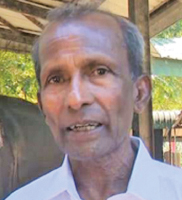
Sumana Banda, a retired elephant keeper
Sumana Banda, who was attached to the Pinnawala Orphanage for 31 years from 1981, said; “There were about 12 elephants when I joined. Young elephants that were orphaned or had fallen into pits and ravines were rescued and provided care at the centre. A considerable number of elephants had been in Kegalle at that time, as the climate and environment have been favourable to them.
“I come from Kotagama, a village about one kilometre from the Orphanage, and four generations of my family have been involved in elephant keeping. I have witnessed instances of elephant births and musth (a period of heightened reproductive activity and aggression in male elephants). I also had the opportunity to travel to Beijing, China and Islamabad, Pakistan, with an elephant.
“After retiring from the orphanage, Sri Dalada Maligawa Diyawadana Nilame Nilanga Dela Bandara entrusted me with the responsibility of looking after Indi Raja, a lead tusker at the Maligawa gifted to Sri Lanka by the then Prime Minister Rajiv Gandhi. Since then, I have participated in the Kandy Perahera and escorted the tusker carrying the sacred tooth relic”.
